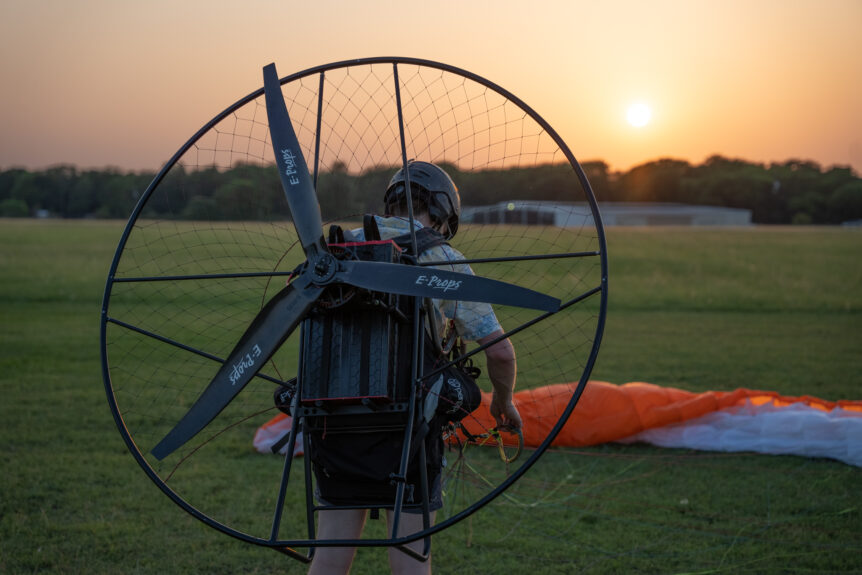Cory O’Neill recently test flew a special conversion of a classic ultralight, the Electric Pterodactyl Ascender. Rising from the desert near Pahrump, Nevada, the light canard was propelled by an open-source power paraglider motor and battery pack – all neatly bundled in a back-pack-size unit.
A True Cross-Country Trip
An early flying wing version of what became the Pterodactyl, the Pfledge lacked a canard and relied on a combination of weight shift and aerodynamic controls. Its designer, Jack McCornack and an early customer, Dave Froble, flew a pair of these craft from Monterrey, California to the 1979 Experimental Aircraft Association fly-in at Oshkosh, Wisconsin. According to Ultralight News.com, “They made a big stir in Oshkosh that year – it is still referred to as ‘the year that ultralights really caught on’. At Oshkosh the editor of the Mother Earth News, an ecological publication, challenged the pair to fly on to Kitty Hawk, [North Carolina] on pure ethanol and offered to buy the alcohol to do it. Never one to turn down gas money McCornack said “yes” and the two completed the flight to North Carolina, requiring just some mixture adjustments to the engines to run on the alcohol fuel. The seven-week trip was perhaps the longest ultralight flight of its day.”
Considering they made the epic trip using a German-made Sachs SA-340 direct drive engine of 336 cc displacement, and despite the uneven reliability of early two-stroke aviation engines, their flight was a major accomplishment for the fledgling ultralight industry. McCornack later added the canard and improved the controls, eliminating the weight-shift element.
The Open Source Power Pack
The All Electric Motor Conversion, crafted by Wolfgang Letto and O’Neill, is a beneficiary of a group effort to provide electric power for paragliders, the Open Source PPG organization. It’s also a huge increase in reliability over the old two-strokes.
This blog reported on the group’s four-motor rev. 4 in 2019, noting its ability to climb 3,000 feet in its 30-minute battery capacity. The latest iteration uses a single motor to drive a three-blade e-Prop and is able to use a single or dual battery pack, good for 30 minutes or one-hour duration.
The four-motor approach is being replaced by the SP140 package, which boasts reliability and operating costs better than those of two-stroke-powered parachutes.
Open Source PPG boasts the following advantages:
“One Moving Part
“Low cost per hour of flying
“No scheduled maintenance
“High reliability
“AVERAGE COST PER HR TO FLY
“SP140 $0.60
“2 Stroke $11.69”
One can see that the PPG motor package could easily be adapted to ultralights, exactly what happened here. The only disadvantage, perhaps, is the half-hour or one-hour endurance of the batteries compared to the hours in the air for gas power.
A Somewhat Scary Training Video
As slick and professional as the presentations from Open-Source PPG are, earlier promotions from the Pterodactyl enterprise were a little more “raw,” including actual clowning around.
One wonders if even in the wild and wooly years of early ultralights, these training approaches were not at little bit foolhardy.


Comments 1
I believe it was Jack and Keith that made that flight in 1979.